NSQIP Initiative: Quality Improvement in Canadian Healthcare
VerifiedAdded on 2023/04/22
|8
|2034
|237
Report
AI Summary
This report provides a comprehensive analysis of the National Surgical Quality Improvement Program (NSQIP) within the Canadian healthcare system, focusing on its components, effectiveness, and impact on surgical outcomes. The report highlights that NSQIP, initially developed by the American College of Surgeons and implemented in the American Veterans Health Administration (VHA), serves as a scientifically proven method for measuring and enhancing the quality of surgical care. Key components of NSQIP include data collection, risk adjustment, and feedback reporting, all aimed at reducing complications and mortalities. The evaluation of the program reveals significant improvements in participating hospitals, such as a reduction in post-operative adverse events, decreased lengths of stay, and increased patient satisfaction. Evidences from the research indicate that hospitals can prevent hundreds of complications, save lives, and reduce medical costs through NSQIP. The report concludes by recommending the broader implementation of NSQIP and the utilization of risk analysis tools to further improve patient care, emphasizing its potential as a leading health improvement initiative.
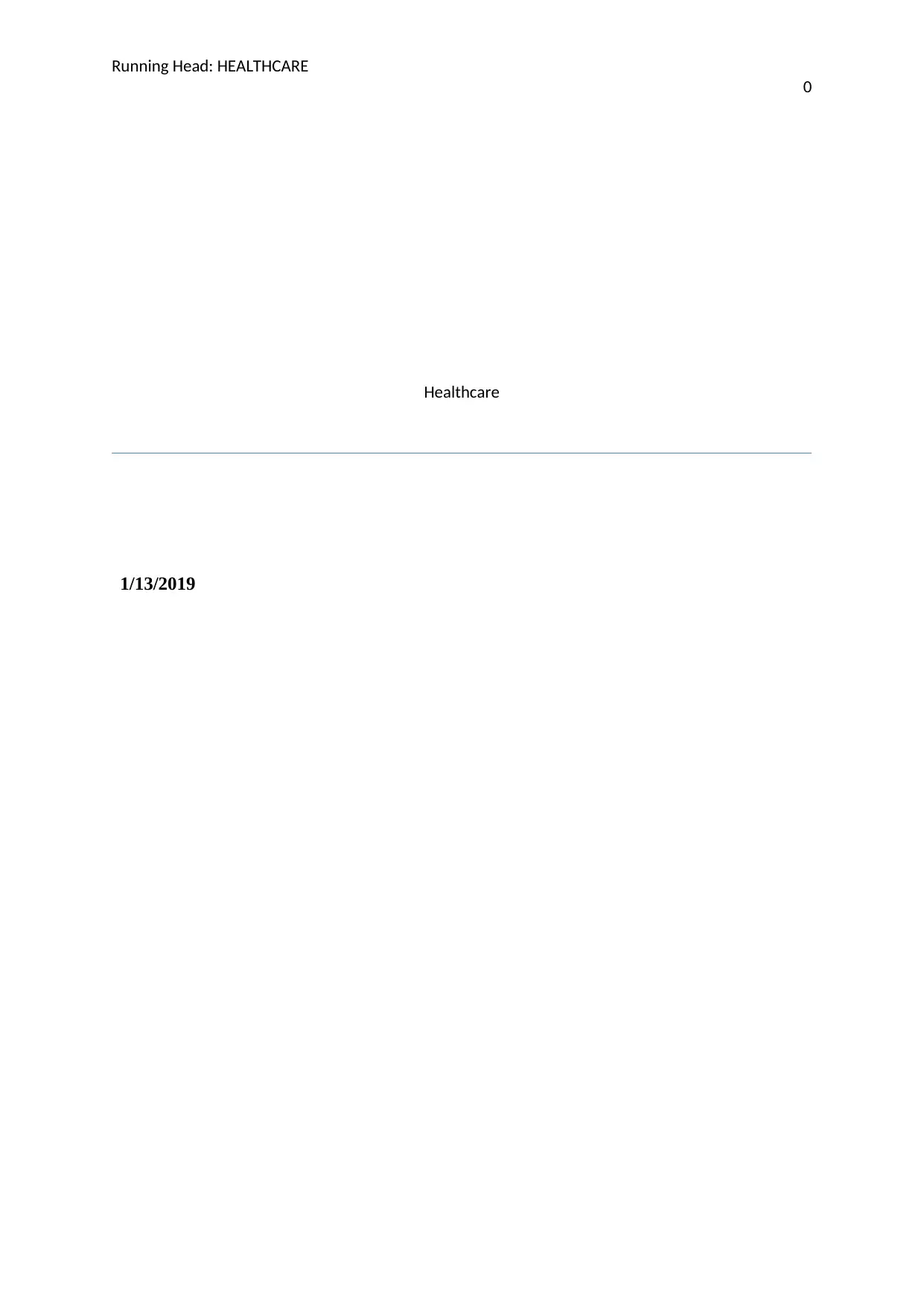
Running Head: HEALTHCARE
0
Healthcare
1/13/2019
0
Healthcare
1/13/2019
Secure Best Marks with AI Grader
Need help grading? Try our AI Grader for instant feedback on your assignments.
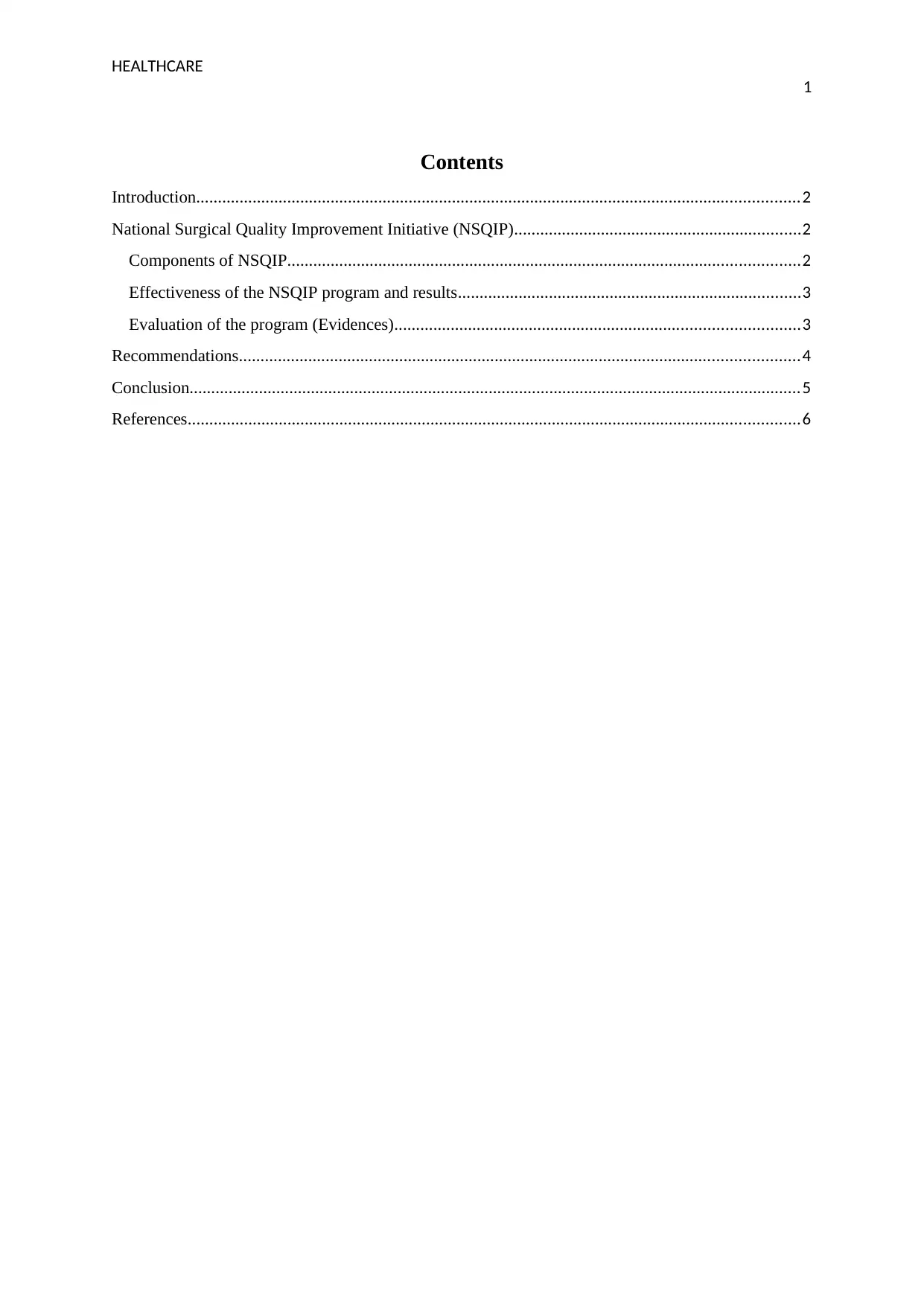
HEALTHCARE
1
Contents
Introduction...........................................................................................................................................2
National Surgical Quality Improvement Initiative (NSQIP)..................................................................2
Components of NSQIP......................................................................................................................2
Effectiveness of the NSQIP program and results...............................................................................3
Evaluation of the program (Evidences).............................................................................................3
Recommendations.................................................................................................................................4
Conclusion.............................................................................................................................................5
References.............................................................................................................................................6
1
Contents
Introduction...........................................................................................................................................2
National Surgical Quality Improvement Initiative (NSQIP)..................................................................2
Components of NSQIP......................................................................................................................2
Effectiveness of the NSQIP program and results...............................................................................3
Evaluation of the program (Evidences).............................................................................................3
Recommendations.................................................................................................................................4
Conclusion.............................................................................................................................................5
References.............................................................................................................................................6
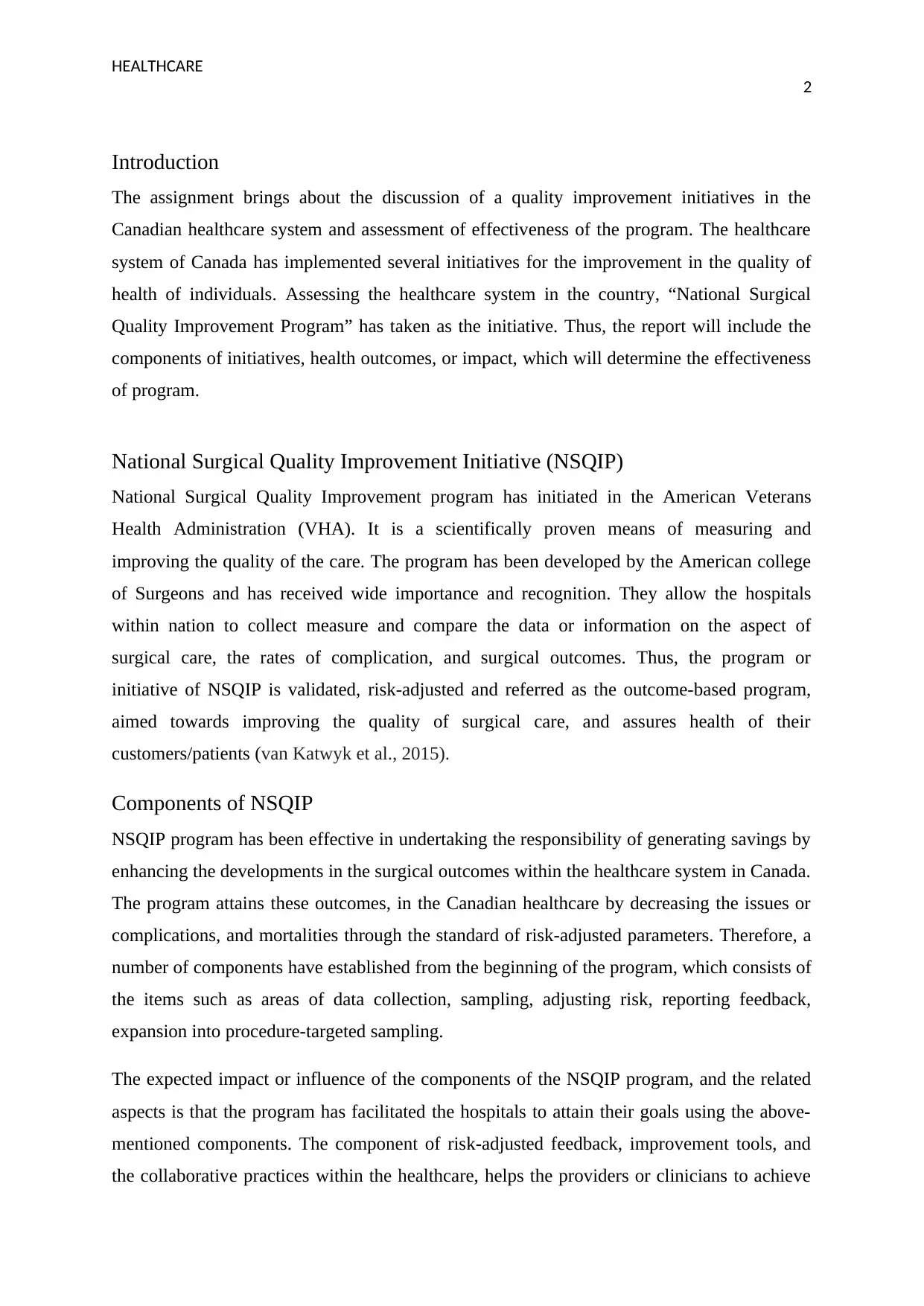
HEALTHCARE
2
Introduction
The assignment brings about the discussion of a quality improvement initiatives in the
Canadian healthcare system and assessment of effectiveness of the program. The healthcare
system of Canada has implemented several initiatives for the improvement in the quality of
health of individuals. Assessing the healthcare system in the country, “National Surgical
Quality Improvement Program” has taken as the initiative. Thus, the report will include the
components of initiatives, health outcomes, or impact, which will determine the effectiveness
of program.
National Surgical Quality Improvement Initiative (NSQIP)
National Surgical Quality Improvement program has initiated in the American Veterans
Health Administration (VHA). It is a scientifically proven means of measuring and
improving the quality of the care. The program has been developed by the American college
of Surgeons and has received wide importance and recognition. They allow the hospitals
within nation to collect measure and compare the data or information on the aspect of
surgical care, the rates of complication, and surgical outcomes. Thus, the program or
initiative of NSQIP is validated, risk-adjusted and referred as the outcome-based program,
aimed towards improving the quality of surgical care, and assures health of their
customers/patients (van Katwyk et al., 2015).
Components of NSQIP
NSQIP program has been effective in undertaking the responsibility of generating savings by
enhancing the developments in the surgical outcomes within the healthcare system in Canada.
The program attains these outcomes, in the Canadian healthcare by decreasing the issues or
complications, and mortalities through the standard of risk-adjusted parameters. Therefore, a
number of components have established from the beginning of the program, which consists of
the items such as areas of data collection, sampling, adjusting risk, reporting feedback,
expansion into procedure-targeted sampling.
The expected impact or influence of the components of the NSQIP program, and the related
aspects is that the program has facilitated the hospitals to attain their goals using the above-
mentioned components. The component of risk-adjusted feedback, improvement tools, and
the collaborative practices within the healthcare, helps the providers or clinicians to achieve
2
Introduction
The assignment brings about the discussion of a quality improvement initiatives in the
Canadian healthcare system and assessment of effectiveness of the program. The healthcare
system of Canada has implemented several initiatives for the improvement in the quality of
health of individuals. Assessing the healthcare system in the country, “National Surgical
Quality Improvement Program” has taken as the initiative. Thus, the report will include the
components of initiatives, health outcomes, or impact, which will determine the effectiveness
of program.
National Surgical Quality Improvement Initiative (NSQIP)
National Surgical Quality Improvement program has initiated in the American Veterans
Health Administration (VHA). It is a scientifically proven means of measuring and
improving the quality of the care. The program has been developed by the American college
of Surgeons and has received wide importance and recognition. They allow the hospitals
within nation to collect measure and compare the data or information on the aspect of
surgical care, the rates of complication, and surgical outcomes. Thus, the program or
initiative of NSQIP is validated, risk-adjusted and referred as the outcome-based program,
aimed towards improving the quality of surgical care, and assures health of their
customers/patients (van Katwyk et al., 2015).
Components of NSQIP
NSQIP program has been effective in undertaking the responsibility of generating savings by
enhancing the developments in the surgical outcomes within the healthcare system in Canada.
The program attains these outcomes, in the Canadian healthcare by decreasing the issues or
complications, and mortalities through the standard of risk-adjusted parameters. Therefore, a
number of components have established from the beginning of the program, which consists of
the items such as areas of data collection, sampling, adjusting risk, reporting feedback,
expansion into procedure-targeted sampling.
The expected impact or influence of the components of the NSQIP program, and the related
aspects is that the program has facilitated the hospitals to attain their goals using the above-
mentioned components. The component of risk-adjusted feedback, improvement tools, and
the collaborative practices within the healthcare, helps the providers or clinicians to achieve
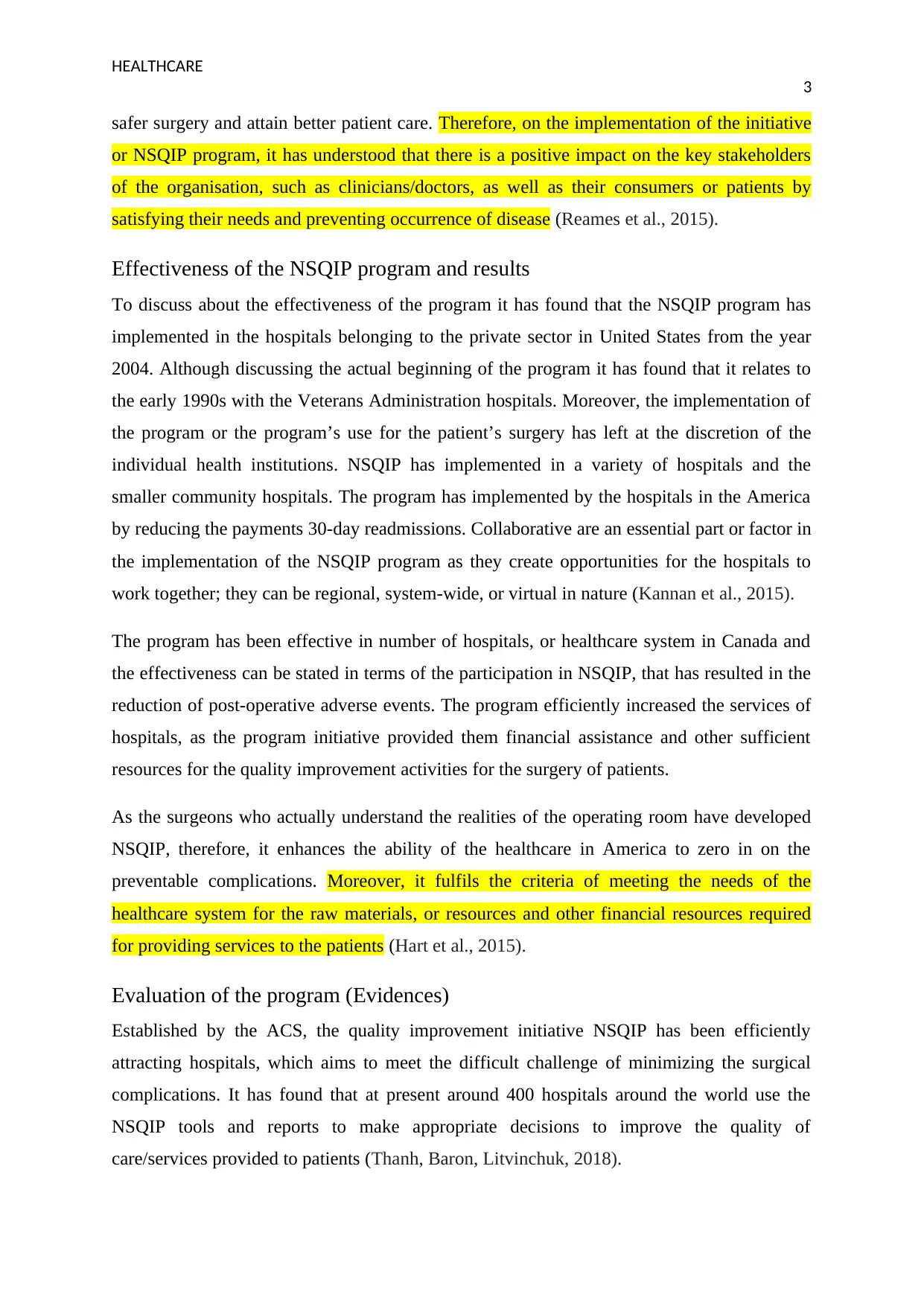
HEALTHCARE
3
safer surgery and attain better patient care. Therefore, on the implementation of the initiative
or NSQIP program, it has understood that there is a positive impact on the key stakeholders
of the organisation, such as clinicians/doctors, as well as their consumers or patients by
satisfying their needs and preventing occurrence of disease (Reames et al., 2015).
Effectiveness of the NSQIP program and results
To discuss about the effectiveness of the program it has found that the NSQIP program has
implemented in the hospitals belonging to the private sector in United States from the year
2004. Although discussing the actual beginning of the program it has found that it relates to
the early 1990s with the Veterans Administration hospitals. Moreover, the implementation of
the program or the program’s use for the patient’s surgery has left at the discretion of the
individual health institutions. NSQIP has implemented in a variety of hospitals and the
smaller community hospitals. The program has implemented by the hospitals in the America
by reducing the payments 30-day readmissions. Collaborative are an essential part or factor in
the implementation of the NSQIP program as they create opportunities for the hospitals to
work together; they can be regional, system-wide, or virtual in nature (Kannan et al., 2015).
The program has been effective in number of hospitals, or healthcare system in Canada and
the effectiveness can be stated in terms of the participation in NSQIP, that has resulted in the
reduction of post-operative adverse events. The program efficiently increased the services of
hospitals, as the program initiative provided them financial assistance and other sufficient
resources for the quality improvement activities for the surgery of patients.
As the surgeons who actually understand the realities of the operating room have developed
NSQIP, therefore, it enhances the ability of the healthcare in America to zero in on the
preventable complications. Moreover, it fulfils the criteria of meeting the needs of the
healthcare system for the raw materials, or resources and other financial resources required
for providing services to the patients (Hart et al., 2015).
Evaluation of the program (Evidences)
Established by the ACS, the quality improvement initiative NSQIP has been efficiently
attracting hospitals, which aims to meet the difficult challenge of minimizing the surgical
complications. It has found that at present around 400 hospitals around the world use the
NSQIP tools and reports to make appropriate decisions to improve the quality of
care/services provided to patients (Thanh, Baron, Litvinchuk, 2018).
3
safer surgery and attain better patient care. Therefore, on the implementation of the initiative
or NSQIP program, it has understood that there is a positive impact on the key stakeholders
of the organisation, such as clinicians/doctors, as well as their consumers or patients by
satisfying their needs and preventing occurrence of disease (Reames et al., 2015).
Effectiveness of the NSQIP program and results
To discuss about the effectiveness of the program it has found that the NSQIP program has
implemented in the hospitals belonging to the private sector in United States from the year
2004. Although discussing the actual beginning of the program it has found that it relates to
the early 1990s with the Veterans Administration hospitals. Moreover, the implementation of
the program or the program’s use for the patient’s surgery has left at the discretion of the
individual health institutions. NSQIP has implemented in a variety of hospitals and the
smaller community hospitals. The program has implemented by the hospitals in the America
by reducing the payments 30-day readmissions. Collaborative are an essential part or factor in
the implementation of the NSQIP program as they create opportunities for the hospitals to
work together; they can be regional, system-wide, or virtual in nature (Kannan et al., 2015).
The program has been effective in number of hospitals, or healthcare system in Canada and
the effectiveness can be stated in terms of the participation in NSQIP, that has resulted in the
reduction of post-operative adverse events. The program efficiently increased the services of
hospitals, as the program initiative provided them financial assistance and other sufficient
resources for the quality improvement activities for the surgery of patients.
As the surgeons who actually understand the realities of the operating room have developed
NSQIP, therefore, it enhances the ability of the healthcare in America to zero in on the
preventable complications. Moreover, it fulfils the criteria of meeting the needs of the
healthcare system for the raw materials, or resources and other financial resources required
for providing services to the patients (Hart et al., 2015).
Evaluation of the program (Evidences)
Established by the ACS, the quality improvement initiative NSQIP has been efficiently
attracting hospitals, which aims to meet the difficult challenge of minimizing the surgical
complications. It has found that at present around 400 hospitals around the world use the
NSQIP tools and reports to make appropriate decisions to improve the quality of
care/services provided to patients (Thanh, Baron, Litvinchuk, 2018).
Secure Best Marks with AI Grader
Need help grading? Try our AI Grader for instant feedback on your assignments.
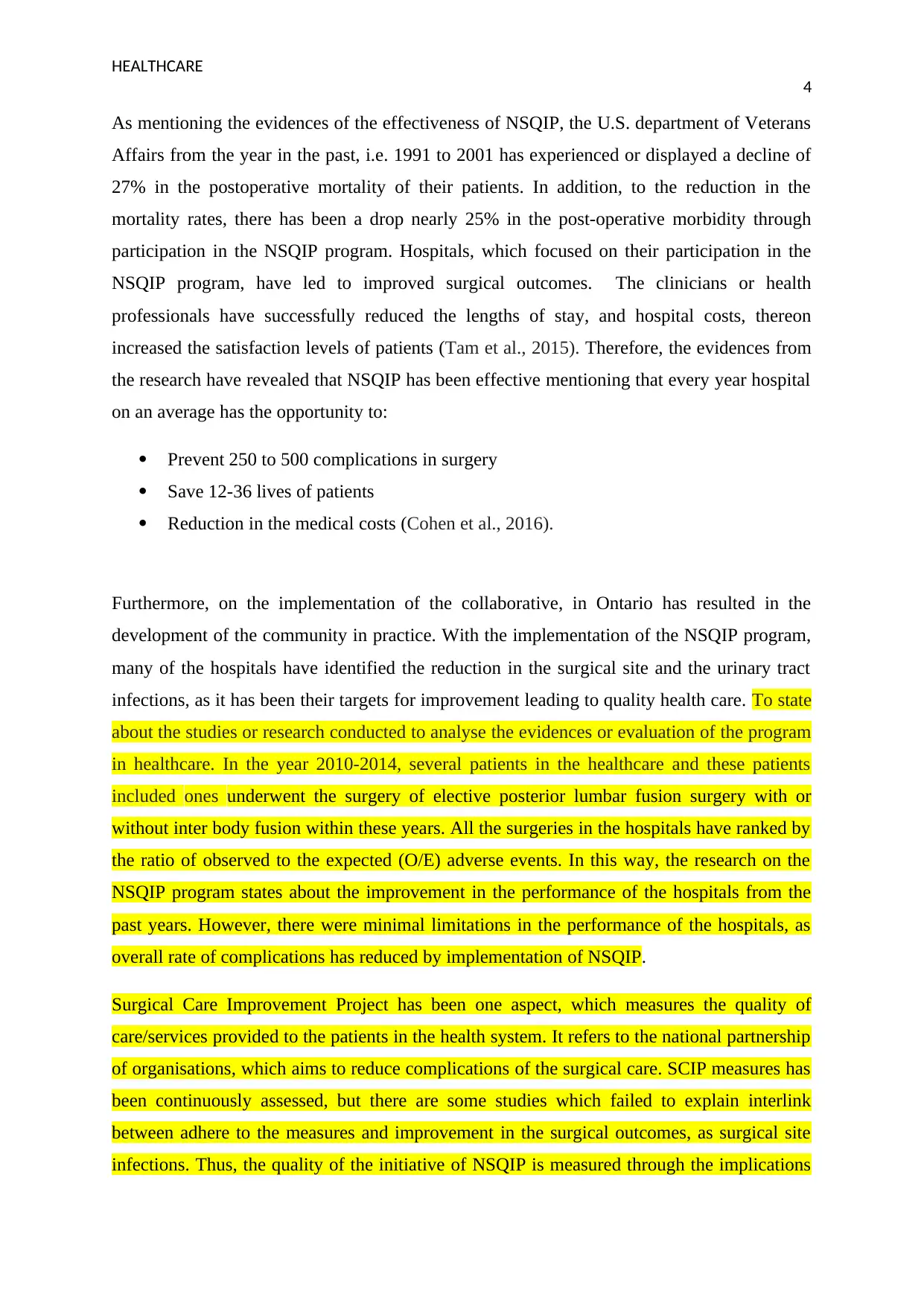
HEALTHCARE
4
As mentioning the evidences of the effectiveness of NSQIP, the U.S. department of Veterans
Affairs from the year in the past, i.e. 1991 to 2001 has experienced or displayed a decline of
27% in the postoperative mortality of their patients. In addition, to the reduction in the
mortality rates, there has been a drop nearly 25% in the post-operative morbidity through
participation in the NSQIP program. Hospitals, which focused on their participation in the
NSQIP program, have led to improved surgical outcomes. The clinicians or health
professionals have successfully reduced the lengths of stay, and hospital costs, thereon
increased the satisfaction levels of patients (Tam et al., 2015). Therefore, the evidences from
the research have revealed that NSQIP has been effective mentioning that every year hospital
on an average has the opportunity to:
Prevent 250 to 500 complications in surgery
Save 12-36 lives of patients
Reduction in the medical costs (Cohen et al., 2016).
Furthermore, on the implementation of the collaborative, in Ontario has resulted in the
development of the community in practice. With the implementation of the NSQIP program,
many of the hospitals have identified the reduction in the surgical site and the urinary tract
infections, as it has been their targets for improvement leading to quality health care. To state
about the studies or research conducted to analyse the evidences or evaluation of the program
in healthcare. In the year 2010-2014, several patients in the healthcare and these patients
included ones underwent the surgery of elective posterior lumbar fusion surgery with or
without inter body fusion within these years. All the surgeries in the hospitals have ranked by
the ratio of observed to the expected (O/E) adverse events. In this way, the research on the
NSQIP program states about the improvement in the performance of the hospitals from the
past years. However, there were minimal limitations in the performance of the hospitals, as
overall rate of complications has reduced by implementation of NSQIP.
Surgical Care Improvement Project has been one aspect, which measures the quality of
care/services provided to the patients in the health system. It refers to the national partnership
of organisations, which aims to reduce complications of the surgical care. SCIP measures has
been continuously assessed, but there are some studies which failed to explain interlink
between adhere to the measures and improvement in the surgical outcomes, as surgical site
infections. Thus, the quality of the initiative of NSQIP is measured through the implications
4
As mentioning the evidences of the effectiveness of NSQIP, the U.S. department of Veterans
Affairs from the year in the past, i.e. 1991 to 2001 has experienced or displayed a decline of
27% in the postoperative mortality of their patients. In addition, to the reduction in the
mortality rates, there has been a drop nearly 25% in the post-operative morbidity through
participation in the NSQIP program. Hospitals, which focused on their participation in the
NSQIP program, have led to improved surgical outcomes. The clinicians or health
professionals have successfully reduced the lengths of stay, and hospital costs, thereon
increased the satisfaction levels of patients (Tam et al., 2015). Therefore, the evidences from
the research have revealed that NSQIP has been effective mentioning that every year hospital
on an average has the opportunity to:
Prevent 250 to 500 complications in surgery
Save 12-36 lives of patients
Reduction in the medical costs (Cohen et al., 2016).
Furthermore, on the implementation of the collaborative, in Ontario has resulted in the
development of the community in practice. With the implementation of the NSQIP program,
many of the hospitals have identified the reduction in the surgical site and the urinary tract
infections, as it has been their targets for improvement leading to quality health care. To state
about the studies or research conducted to analyse the evidences or evaluation of the program
in healthcare. In the year 2010-2014, several patients in the healthcare and these patients
included ones underwent the surgery of elective posterior lumbar fusion surgery with or
without inter body fusion within these years. All the surgeries in the hospitals have ranked by
the ratio of observed to the expected (O/E) adverse events. In this way, the research on the
NSQIP program states about the improvement in the performance of the hospitals from the
past years. However, there were minimal limitations in the performance of the hospitals, as
overall rate of complications has reduced by implementation of NSQIP.
Surgical Care Improvement Project has been one aspect, which measures the quality of
care/services provided to the patients in the health system. It refers to the national partnership
of organisations, which aims to reduce complications of the surgical care. SCIP measures has
been continuously assessed, but there are some studies which failed to explain interlink
between adhere to the measures and improvement in the surgical outcomes, as surgical site
infections. Thus, the quality of the initiative of NSQIP is measured through the implications
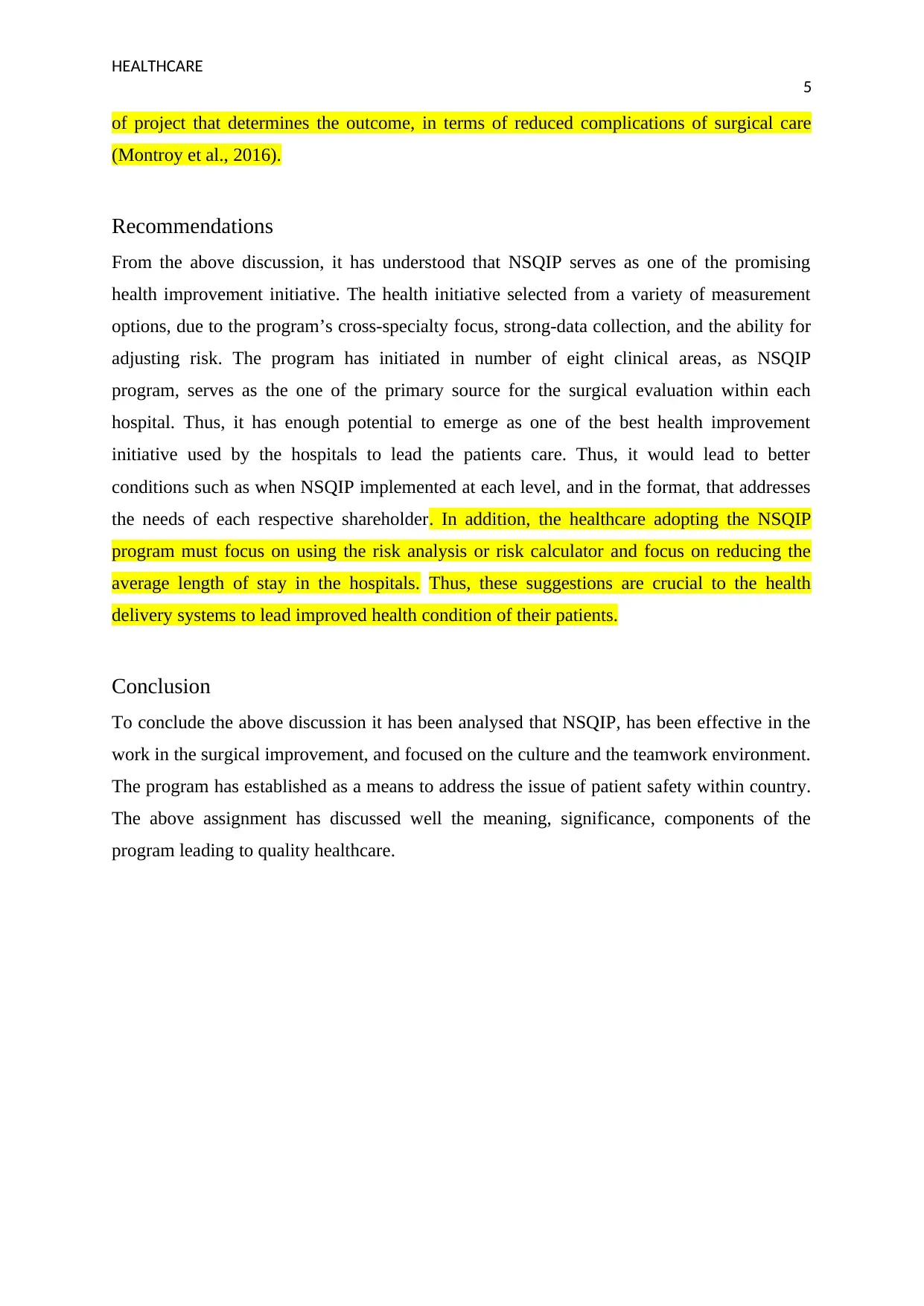
HEALTHCARE
5
of project that determines the outcome, in terms of reduced complications of surgical care
(Montroy et al., 2016).
Recommendations
From the above discussion, it has understood that NSQIP serves as one of the promising
health improvement initiative. The health initiative selected from a variety of measurement
options, due to the program’s cross-specialty focus, strong-data collection, and the ability for
adjusting risk. The program has initiated in number of eight clinical areas, as NSQIP
program, serves as the one of the primary source for the surgical evaluation within each
hospital. Thus, it has enough potential to emerge as one of the best health improvement
initiative used by the hospitals to lead the patients care. Thus, it would lead to better
conditions such as when NSQIP implemented at each level, and in the format, that addresses
the needs of each respective shareholder. In addition, the healthcare adopting the NSQIP
program must focus on using the risk analysis or risk calculator and focus on reducing the
average length of stay in the hospitals. Thus, these suggestions are crucial to the health
delivery systems to lead improved health condition of their patients.
Conclusion
To conclude the above discussion it has been analysed that NSQIP, has been effective in the
work in the surgical improvement, and focused on the culture and the teamwork environment.
The program has established as a means to address the issue of patient safety within country.
The above assignment has discussed well the meaning, significance, components of the
program leading to quality healthcare.
5
of project that determines the outcome, in terms of reduced complications of surgical care
(Montroy et al., 2016).
Recommendations
From the above discussion, it has understood that NSQIP serves as one of the promising
health improvement initiative. The health initiative selected from a variety of measurement
options, due to the program’s cross-specialty focus, strong-data collection, and the ability for
adjusting risk. The program has initiated in number of eight clinical areas, as NSQIP
program, serves as the one of the primary source for the surgical evaluation within each
hospital. Thus, it has enough potential to emerge as one of the best health improvement
initiative used by the hospitals to lead the patients care. Thus, it would lead to better
conditions such as when NSQIP implemented at each level, and in the format, that addresses
the needs of each respective shareholder. In addition, the healthcare adopting the NSQIP
program must focus on using the risk analysis or risk calculator and focus on reducing the
average length of stay in the hospitals. Thus, these suggestions are crucial to the health
delivery systems to lead improved health condition of their patients.
Conclusion
To conclude the above discussion it has been analysed that NSQIP, has been effective in the
work in the surgical improvement, and focused on the culture and the teamwork environment.
The program has established as a means to address the issue of patient safety within country.
The above assignment has discussed well the meaning, significance, components of the
program leading to quality healthcare.
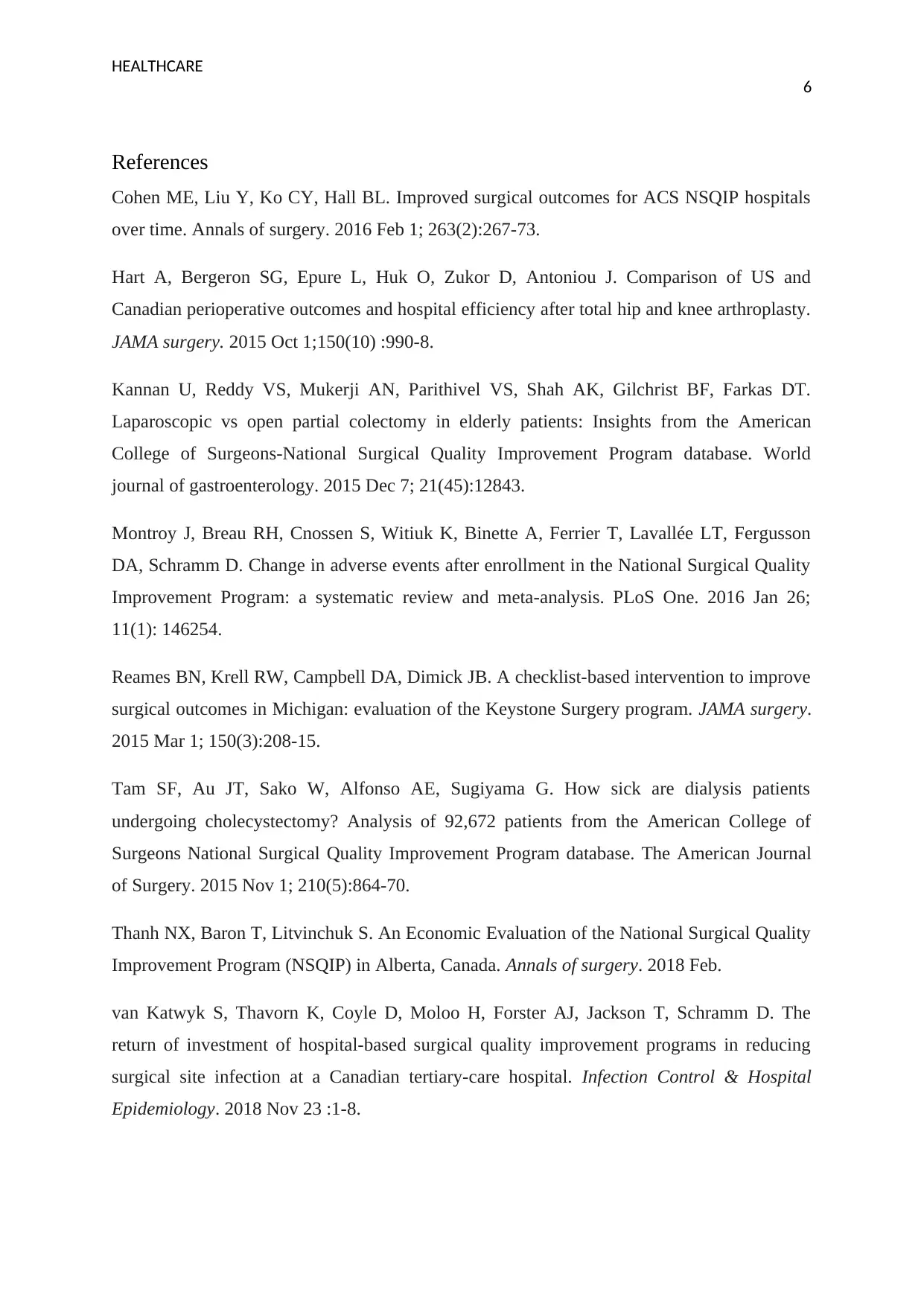
HEALTHCARE
6
References
Cohen ME, Liu Y, Ko CY, Hall BL. Improved surgical outcomes for ACS NSQIP hospitals
over time. Annals of surgery. 2016 Feb 1; 263(2):267-73.
Hart A, Bergeron SG, Epure L, Huk O, Zukor D, Antoniou J. Comparison of US and
Canadian perioperative outcomes and hospital efficiency after total hip and knee arthroplasty.
JAMA surgery. 2015 Oct 1;150(10) :990-8.
Kannan U, Reddy VS, Mukerji AN, Parithivel VS, Shah AK, Gilchrist BF, Farkas DT.
Laparoscopic vs open partial colectomy in elderly patients: Insights from the American
College of Surgeons-National Surgical Quality Improvement Program database. World
journal of gastroenterology. 2015 Dec 7; 21(45):12843.
Montroy J, Breau RH, Cnossen S, Witiuk K, Binette A, Ferrier T, Lavallée LT, Fergusson
DA, Schramm D. Change in adverse events after enrollment in the National Surgical Quality
Improvement Program: a systematic review and meta-analysis. PLoS One. 2016 Jan 26;
11(1): 146254.
Reames BN, Krell RW, Campbell DA, Dimick JB. A checklist-based intervention to improve
surgical outcomes in Michigan: evaluation of the Keystone Surgery program. JAMA surgery.
2015 Mar 1; 150(3):208-15.
Tam SF, Au JT, Sako W, Alfonso AE, Sugiyama G. How sick are dialysis patients
undergoing cholecystectomy? Analysis of 92,672 patients from the American College of
Surgeons National Surgical Quality Improvement Program database. The American Journal
of Surgery. 2015 Nov 1; 210(5):864-70.
Thanh NX, Baron T, Litvinchuk S. An Economic Evaluation of the National Surgical Quality
Improvement Program (NSQIP) in Alberta, Canada. Annals of surgery. 2018 Feb.
van Katwyk S, Thavorn K, Coyle D, Moloo H, Forster AJ, Jackson T, Schramm D. The
return of investment of hospital-based surgical quality improvement programs in reducing
surgical site infection at a Canadian tertiary-care hospital. Infection Control & Hospital
Epidemiology. 2018 Nov 23 :1-8.
6
References
Cohen ME, Liu Y, Ko CY, Hall BL. Improved surgical outcomes for ACS NSQIP hospitals
over time. Annals of surgery. 2016 Feb 1; 263(2):267-73.
Hart A, Bergeron SG, Epure L, Huk O, Zukor D, Antoniou J. Comparison of US and
Canadian perioperative outcomes and hospital efficiency after total hip and knee arthroplasty.
JAMA surgery. 2015 Oct 1;150(10) :990-8.
Kannan U, Reddy VS, Mukerji AN, Parithivel VS, Shah AK, Gilchrist BF, Farkas DT.
Laparoscopic vs open partial colectomy in elderly patients: Insights from the American
College of Surgeons-National Surgical Quality Improvement Program database. World
journal of gastroenterology. 2015 Dec 7; 21(45):12843.
Montroy J, Breau RH, Cnossen S, Witiuk K, Binette A, Ferrier T, Lavallée LT, Fergusson
DA, Schramm D. Change in adverse events after enrollment in the National Surgical Quality
Improvement Program: a systematic review and meta-analysis. PLoS One. 2016 Jan 26;
11(1): 146254.
Reames BN, Krell RW, Campbell DA, Dimick JB. A checklist-based intervention to improve
surgical outcomes in Michigan: evaluation of the Keystone Surgery program. JAMA surgery.
2015 Mar 1; 150(3):208-15.
Tam SF, Au JT, Sako W, Alfonso AE, Sugiyama G. How sick are dialysis patients
undergoing cholecystectomy? Analysis of 92,672 patients from the American College of
Surgeons National Surgical Quality Improvement Program database. The American Journal
of Surgery. 2015 Nov 1; 210(5):864-70.
Thanh NX, Baron T, Litvinchuk S. An Economic Evaluation of the National Surgical Quality
Improvement Program (NSQIP) in Alberta, Canada. Annals of surgery. 2018 Feb.
van Katwyk S, Thavorn K, Coyle D, Moloo H, Forster AJ, Jackson T, Schramm D. The
return of investment of hospital-based surgical quality improvement programs in reducing
surgical site infection at a Canadian tertiary-care hospital. Infection Control & Hospital
Epidemiology. 2018 Nov 23 :1-8.
Paraphrase This Document
Need a fresh take? Get an instant paraphrase of this document with our AI Paraphraser

HEALTHCARE
7
7
1 out of 8
Related Documents
Your All-in-One AI-Powered Toolkit for Academic Success.
+13062052269
info@desklib.com
Available 24*7 on WhatsApp / Email
![[object Object]](/_next/static/media/star-bottom.7253800d.svg)
Unlock your academic potential
© 2024 | Zucol Services PVT LTD | All rights reserved.





